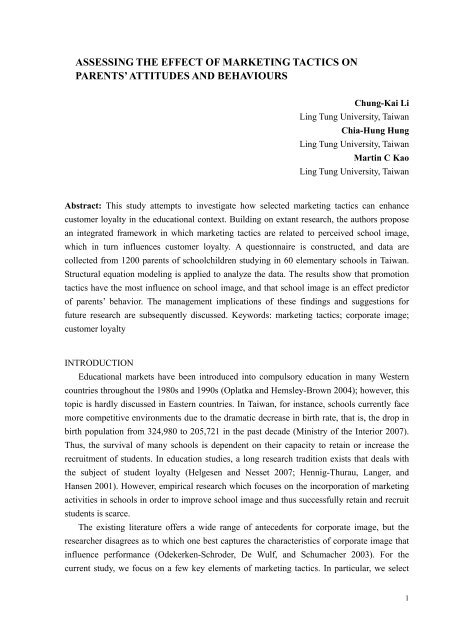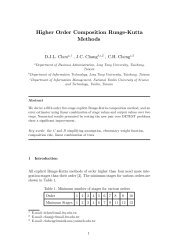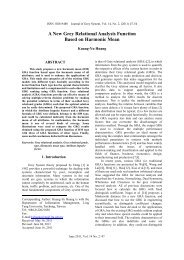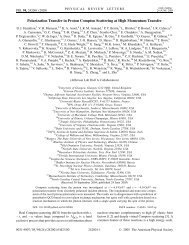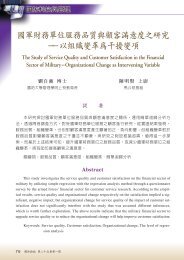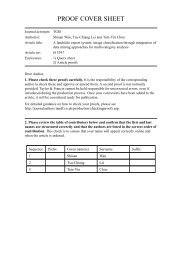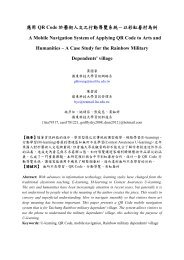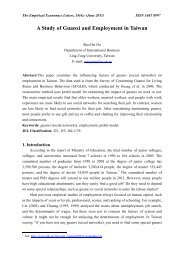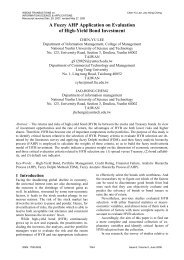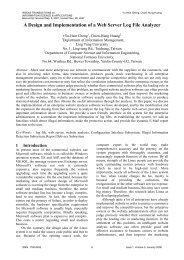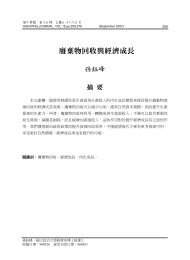assessing the effect of marketing tactics on parents
assessing the effect of marketing tactics on parents
assessing the effect of marketing tactics on parents
Create successful ePaper yourself
Turn your PDF publications into a flip-book with our unique Google optimized e-Paper software.
ASSESSING THE EFFECT OF MARKETING TACTICS ONPARENTS’ ATTITUDES AND BEHAVIOURSChung-Kai LiLing Tung University, TaiwanChia-Hung HungLing Tung University, TaiwanMartin C KaoLing Tung University, TaiwanAbstract: This study attempts to investigate how selected <str<strong>on</strong>g>marketing</str<strong>on</strong>g> <str<strong>on</strong>g>tactics</str<strong>on</strong>g> can enhancecustomer loyalty in <str<strong>on</strong>g>the</str<strong>on</strong>g> educati<strong>on</strong>al c<strong>on</strong>text. Building <strong>on</strong> extant research, <str<strong>on</strong>g>the</str<strong>on</strong>g> authors proposean integrated framework in which <str<strong>on</strong>g>marketing</str<strong>on</strong>g> <str<strong>on</strong>g>tactics</str<strong>on</strong>g> are related to perceived school image,which in turn influences customer loyalty. A questi<strong>on</strong>naire is c<strong>on</strong>structed, and data arecollected from 1200 <strong>parents</strong> <str<strong>on</strong>g>of</str<strong>on</strong>g> schoolchildren studying in 60 elementary schools in Taiwan.Structural equati<strong>on</strong> modeling is applied to analyze <str<strong>on</strong>g>the</str<strong>on</strong>g> data. The results show that promoti<strong>on</strong><str<strong>on</strong>g>tactics</str<strong>on</strong>g> have <str<strong>on</strong>g>the</str<strong>on</strong>g> most influence <strong>on</strong> school image, and that school image is an <str<strong>on</strong>g>effect</str<strong>on</strong>g> predictor<str<strong>on</strong>g>of</str<strong>on</strong>g> <strong>parents</strong>’ behavior. The management implicati<strong>on</strong>s <str<strong>on</strong>g>of</str<strong>on</strong>g> <str<strong>on</strong>g>the</str<strong>on</strong>g>se findings and suggesti<strong>on</strong>s forfuture research are subsequently discussed. Keywords: <str<strong>on</strong>g>marketing</str<strong>on</strong>g> <str<strong>on</strong>g>tactics</str<strong>on</strong>g>; corporate image;customer loyaltyINTRODUCTIONEducati<strong>on</strong>al markets have been introduced into compulsory educati<strong>on</strong> in many Westerncountries throughout <str<strong>on</strong>g>the</str<strong>on</strong>g> 1980s and 1990s (Oplatka and Hemsley-Brown 2004); however, thistopic is hardly discussed in Eastern countries. In Taiwan, for instance, schools currently facemore competitive envir<strong>on</strong>ments due to <str<strong>on</strong>g>the</str<strong>on</strong>g> dramatic decrease in birth rate, that is, <str<strong>on</strong>g>the</str<strong>on</strong>g> drop inbirth populati<strong>on</strong> from 324,980 to 205,721 in <str<strong>on</strong>g>the</str<strong>on</strong>g> past decade (Ministry <str<strong>on</strong>g>of</str<strong>on</strong>g> <str<strong>on</strong>g>the</str<strong>on</strong>g> Interior 2007).Thus, <str<strong>on</strong>g>the</str<strong>on</strong>g> survival <str<strong>on</strong>g>of</str<strong>on</strong>g> many schools is dependent <strong>on</strong> <str<strong>on</strong>g>the</str<strong>on</strong>g>ir capacity to retain or increase <str<strong>on</strong>g>the</str<strong>on</strong>g>recruitment <str<strong>on</strong>g>of</str<strong>on</strong>g> students. In educati<strong>on</strong> studies, a l<strong>on</strong>g research traditi<strong>on</strong> exists that deals with<str<strong>on</strong>g>the</str<strong>on</strong>g> subject <str<strong>on</strong>g>of</str<strong>on</strong>g> student loyalty (Helgesen and Nesset 2007; Hennig-Thurau, Langer, andHansen 2001). However, empirical research which focuses <strong>on</strong> <str<strong>on</strong>g>the</str<strong>on</strong>g> incorporati<strong>on</strong> <str<strong>on</strong>g>of</str<strong>on</strong>g> <str<strong>on</strong>g>marketing</str<strong>on</strong>g>activities in schools in order to improve school image and thus successfully retain and recruitstudents is scarce.The existing literature <str<strong>on</strong>g>of</str<strong>on</strong>g>fers a wide range <str<strong>on</strong>g>of</str<strong>on</strong>g> antecedents for corporate image, but <str<strong>on</strong>g>the</str<strong>on</strong>g>researcher disagrees as to which <strong>on</strong>e best captures <str<strong>on</strong>g>the</str<strong>on</strong>g> characteristics <str<strong>on</strong>g>of</str<strong>on</strong>g> corporate image thatinfluence performance (Odekerken-Schroder, De Wulf, and Schumacher 2003). For <str<strong>on</strong>g>the</str<strong>on</strong>g>current study, we focus <strong>on</strong> a few key elements <str<strong>on</strong>g>of</str<strong>on</strong>g> <str<strong>on</strong>g>marketing</str<strong>on</strong>g> <str<strong>on</strong>g>tactics</str<strong>on</strong>g>. In particular, we select1
product mix, people mix, price mix, place mix, and promoti<strong>on</strong> mix as a representative set <str<strong>on</strong>g>of</str<strong>on</strong>g><str<strong>on</strong>g>marketing</str<strong>on</strong>g> programs. Knowing how certain <str<strong>on</strong>g>marketing</str<strong>on</strong>g> <str<strong>on</strong>g>tactics</str<strong>on</strong>g> c<strong>on</strong>tribute to school image and<str<strong>on</strong>g>the</str<strong>on</strong>g>n to c<strong>on</strong>sumer attitudes and behavior will enable school principals to develop <str<strong>on</strong>g>effect</str<strong>on</strong>g>ive<str<strong>on</strong>g>marketing</str<strong>on</strong>g> plans.In this article, we seek to answer <str<strong>on</strong>g>the</str<strong>on</strong>g> following research questi<strong>on</strong>s: (1) Which <str<strong>on</strong>g>marketing</str<strong>on</strong>g>strategies are most <str<strong>on</strong>g>effect</str<strong>on</strong>g>ive for building school image? And (2) Does school image asmediating variable <str<strong>on</strong>g>effect</str<strong>on</strong>g>ive in influencing <strong>parents</strong>’ loyalty?CONCEPTUAL MODEL AND HYPOTHESESThe main purpose <str<strong>on</strong>g>of</str<strong>on</strong>g> our study was to investigate <str<strong>on</strong>g>the</str<strong>on</strong>g> relati<strong>on</strong>ship between school<str<strong>on</strong>g>marketing</str<strong>on</strong>g> <str<strong>on</strong>g>tactics</str<strong>on</strong>g> and <strong>parents</strong>’ loyalty. Figure 1 depicts <str<strong>on</strong>g>the</str<strong>on</strong>g> research model underlying ourstudy. We delineated our model into two porti<strong>on</strong>s. Porti<strong>on</strong> 1 deals with <strong>parents</strong>’ perceived<str<strong>on</strong>g>marketing</str<strong>on</strong>g> <str<strong>on</strong>g>tactics</str<strong>on</strong>g> and <str<strong>on</strong>g>the</str<strong>on</strong>g>ir <str<strong>on</strong>g>effect</str<strong>on</strong>g> <strong>on</strong> school image. Porti<strong>on</strong> 2 includes school image aspredictors <str<strong>on</strong>g>of</str<strong>on</strong>g> <strong>parents</strong>’ loyalty. We present below <str<strong>on</strong>g>the</str<strong>on</strong>g> literature review and <str<strong>on</strong>g>the</str<strong>on</strong>g> hypo<str<strong>on</strong>g>the</str<strong>on</strong>g>sesdeveloped.Marketing <str<strong>on</strong>g>tactics</str<strong>on</strong>g>1. Product mix2. People mix3. Price mix4. Place mix5. Promoti<strong>on</strong> mixH1School imageH2Parents’ loyaltyFigure 1: C<strong>on</strong>ceptual modelResearch Hypo<str<strong>on</strong>g>the</str<strong>on</strong>g>sesMarketing <str<strong>on</strong>g>tactics</str<strong>on</strong>g> and school imageKolter and Fox (1995) defined educati<strong>on</strong>al <str<strong>on</strong>g>marketing</str<strong>on</strong>g> as “<str<strong>on</strong>g>the</str<strong>on</strong>g> analysis, planning,implementati<strong>on</strong>, and c<strong>on</strong>trol <str<strong>on</strong>g>of</str<strong>on</strong>g> carefully formulated programs designed to bring aboutvoluntary exchanges <str<strong>on</strong>g>of</str<strong>on</strong>g> values with a target market to achieve organizati<strong>on</strong>al objects.”In this study, we investigated <strong>parents</strong>’ percepti<strong>on</strong>s <str<strong>on</strong>g>of</str<strong>on</strong>g> five selected strategic <str<strong>on</strong>g>marketing</str<strong>on</strong>g>elements, namely, product, people, price, place, and promoti<strong>on</strong>. The selected factors do notembrace all types <str<strong>on</strong>g>of</str<strong>on</strong>g> <str<strong>on</strong>g>marketing</str<strong>on</strong>g> efforts but are representative enough <str<strong>on</strong>g>of</str<strong>on</strong>g> <str<strong>on</strong>g>the</str<strong>on</strong>g> efforts and <str<strong>on</strong>g>the</str<strong>on</strong>g>formati<strong>on</strong> <str<strong>on</strong>g>of</str<strong>on</strong>g> school image.Product mix. Product mix in this study refers to school infrastructure such as <str<strong>on</strong>g>the</str<strong>on</strong>g> library,computers, and teaching facilities. Price et al.’s (2003) study showed that students’percepti<strong>on</strong>s <str<strong>on</strong>g>of</str<strong>on</strong>g> a university’s facilities are <strong>on</strong>e <str<strong>on</strong>g>of</str<strong>on</strong>g> <str<strong>on</strong>g>the</str<strong>on</strong>g> main influences for <str<strong>on</strong>g>the</str<strong>on</strong>g>ir choice <str<strong>on</strong>g>of</str<strong>on</strong>g> school.O<str<strong>on</strong>g>the</str<strong>on</strong>g>r empirical studies support <str<strong>on</strong>g>the</str<strong>on</strong>g> view that satisfacti<strong>on</strong> with <str<strong>on</strong>g>the</str<strong>on</strong>g> facilities and equipment is2
positively related to overall school satisfacti<strong>on</strong> (Friedman, Bobrowski, and Geraci 2006),which in turn enhances students’ loyalty (Helgesen and Nesset 2007). Palacio, Meneses, andPerez’s (2002) study also showed that <str<strong>on</strong>g>the</str<strong>on</strong>g> facility comp<strong>on</strong>ent <str<strong>on</strong>g>of</str<strong>on</strong>g> cognitive image positivelyand significantly influences <str<strong>on</strong>g>the</str<strong>on</strong>g> overall image <str<strong>on</strong>g>of</str<strong>on</strong>g> <str<strong>on</strong>g>the</str<strong>on</strong>g> university.People mix. People mix in this study refers to teachers’ ability, skill, knowledge,experience, and care for <str<strong>on</strong>g>the</str<strong>on</strong>g> students. Douglas, Douglas, and Barnes (2006) asserted that <str<strong>on</strong>g>the</str<strong>on</strong>g>most important aspects that influence students’ satisfacti<strong>on</strong> were associated with teaching andlearning, while a number <str<strong>on</strong>g>of</str<strong>on</strong>g> scholars support <str<strong>on</strong>g>the</str<strong>on</strong>g> view that teachers’ ability, communicati<strong>on</strong>,and expertise are positively related to overall school satisfacti<strong>on</strong> (Friedman, Bobrowski, andGeraci 2006; Marzo-Navarro, Pedraja-Iglesias, and Rivera-Torres 2005) which in turnenhances students’ loyalty (Helgesen and Nesset 2007). Palacio, Meneses, and Perez’s (2002)study also showed that <str<strong>on</strong>g>the</str<strong>on</strong>g> teaching staff comp<strong>on</strong>ent <str<strong>on</strong>g>of</str<strong>on</strong>g> cognitive image positively andsignificantly influences <str<strong>on</strong>g>the</str<strong>on</strong>g> overall image <str<strong>on</strong>g>of</str<strong>on</strong>g> <str<strong>on</strong>g>the</str<strong>on</strong>g> university. Services are delivered to <str<strong>on</strong>g>the</str<strong>on</strong>g>student by <str<strong>on</strong>g>the</str<strong>on</strong>g> teacher, and this moment <str<strong>on</strong>g>of</str<strong>on</strong>g> truth can make or break a university’s image(Banwet and Datta 2003).Price mix. According to <str<strong>on</strong>g>the</str<strong>on</strong>g> Ministry <str<strong>on</strong>g>of</str<strong>on</strong>g> Educati<strong>on</strong> (MOE), all elementary schools inTaiwan are to charge <str<strong>on</strong>g>the</str<strong>on</strong>g> same tuiti<strong>on</strong> fee. Therefore, price mix in this study will provide avariety <str<strong>on</strong>g>of</str<strong>on</strong>g> scholarships and bursary. Marzo-Navarro, Pedraja-Iglesias, and Rivera-Torres(2005) showed that enrolment is <str<strong>on</strong>g>the</str<strong>on</strong>g> element that has an impact <strong>on</strong> student satisfacti<strong>on</strong>, andthis satisfacti<strong>on</strong> explains <str<strong>on</strong>g>the</str<strong>on</strong>g> intent to recommend <str<strong>on</strong>g>the</str<strong>on</strong>g> courses.Place mix. Place mix in this study refers to whe<str<strong>on</strong>g>the</str<strong>on</strong>g>r <str<strong>on</strong>g>the</str<strong>on</strong>g> school’s locati<strong>on</strong> is accessible andtraffic is c<strong>on</strong>venient. Place appears as a heterogeneous phenomen<strong>on</strong>, which is created by eachschool at each place. Although it is a way <str<strong>on</strong>g>of</str<strong>on</strong>g> combining local and distant resources, locati<strong>on</strong>c<strong>on</strong>venience reduces <str<strong>on</strong>g>the</str<strong>on</strong>g> time <strong>parents</strong> and students must travel back and forth from schoolevery day, thus perceiving more value from <str<strong>on</strong>g>the</str<strong>on</strong>g> school. The increased value results mostlyfrom <str<strong>on</strong>g>the</str<strong>on</strong>g> reducti<strong>on</strong> in time sacrifices that <str<strong>on</strong>g>the</str<strong>on</strong>g> <strong>parents</strong> must make to escort <str<strong>on</strong>g>the</str<strong>on</strong>g> child to school.Such increased value leads to <str<strong>on</strong>g>the</str<strong>on</strong>g> <strong>parents</strong>’ greater perceived school image (Yoo, D<strong>on</strong>thu, andLee 2000). Although <str<strong>on</strong>g>the</str<strong>on</strong>g>re is a lack <str<strong>on</strong>g>of</str<strong>on</strong>g> empirical evidence to support this relati<strong>on</strong>ship, itappears logical that place mix is associated with school image.Promoti<strong>on</strong> mix. In this study, promoti<strong>on</strong> mix refers to <str<strong>on</strong>g>the</str<strong>on</strong>g> informati<strong>on</strong> sharing with<strong>parents</strong> via formal or informal media (e.g., leaflets, letters, brochures, Internet portals, or PTAmeetings). Most schools engage in press and n<strong>on</strong>-press public relati<strong>on</strong>s. It is largely evidentthat schools in many countries that adopted educati<strong>on</strong>al market policies expended much effortin gaining enhanced press coverage <str<strong>on</strong>g>of</str<strong>on</strong>g> <str<strong>on</strong>g>the</str<strong>on</strong>g>ir activities in order to promote <str<strong>on</strong>g>the</str<strong>on</strong>g>ir image andrecruit prospective students (Oplatka and Hemsley-Brown 2004).School image can be formed by various c<strong>on</strong>stituencies about many different entities and is<str<strong>on</strong>g>the</str<strong>on</strong>g> result <str<strong>on</strong>g>of</str<strong>on</strong>g> an accumulated process which incorporates experience over time, diverseinformati<strong>on</strong>, and <str<strong>on</strong>g>marketing</str<strong>on</strong>g> activities <str<strong>on</strong>g>of</str<strong>on</strong>g> <str<strong>on</strong>g>the</str<strong>on</strong>g> school. The established and developed school3
image can be rapidly improved by technological breakthroughs and unexpected achievementsor, c<strong>on</strong>versely, be destroyed by neglect <str<strong>on</strong>g>of</str<strong>on</strong>g> <str<strong>on</strong>g>the</str<strong>on</strong>g> needs and expectati<strong>on</strong>s <str<strong>on</strong>g>of</str<strong>on</strong>g> various <strong>parents</strong> whointeract with <str<strong>on</strong>g>the</str<strong>on</strong>g> school (Nguyen and Leblanc 2001). Therefore, school image can beenhanced. when <strong>parents</strong> are satisfied with <str<strong>on</strong>g>the</str<strong>on</strong>g> perceived school <str<strong>on</strong>g>marketing</str<strong>on</strong>g> activities. Thus, <str<strong>on</strong>g>the</str<strong>on</strong>g>first hypo<str<strong>on</strong>g>the</str<strong>on</strong>g>sis is as follows:H1a-e: A selected school <str<strong>on</strong>g>marketing</str<strong>on</strong>g> mix element, that is, (H1a) product, (H1b) people, (H1c)price, (H1d) place, and (H1e) promoti<strong>on</strong>, is positively related to school image.School image and <strong>parents</strong>’ loyaltyThe development, maintenance, and enhancement <str<strong>on</strong>g>of</str<strong>on</strong>g> customer loyalty toward a firm’sproducts or services are generally seen as <str<strong>on</strong>g>the</str<strong>on</strong>g> central thrust <str<strong>on</strong>g>of</str<strong>on</strong>g> <str<strong>on</strong>g>marketing</str<strong>on</strong>g> activities (Dick andBasu 1994). Higher customer loyalty implies higher market share and pr<str<strong>on</strong>g>of</str<strong>on</strong>g>itability (Chaudhuriand Holbrook 2001; Fornell and Wernerfelt 1988; Reichheld, Markey, and Hopt<strong>on</strong> 2000). Thisincreased customer loyalty can also help lower <str<strong>on</strong>g>marketing</str<strong>on</strong>g> costs, solicit more customers, and<str<strong>on</strong>g>effect</str<strong>on</strong>g>ively operate trading leverage (Aaker 1997). Moreover, loyal customers foster positiveword-<str<strong>on</strong>g>of</str<strong>on</strong>g>-mouth promoti<strong>on</strong>, advocacy, and customer referrals (Dick and Basu 1994). It is nosurprise <str<strong>on</strong>g>the</str<strong>on</strong>g>n that companies want to retain and develop <str<strong>on</strong>g>the</str<strong>on</strong>g>ir loyal customers.Paralleling <str<strong>on</strong>g>the</str<strong>on</strong>g> related c<strong>on</strong>cept <str<strong>on</strong>g>of</str<strong>on</strong>g> customer loyalty, <strong>parents</strong>’ loyalty c<strong>on</strong>tains an attitudinaland a behavioral comp<strong>on</strong>ent (Dick and Basu 1994). The term “<strong>parents</strong>’ loyalty” means that<strong>parents</strong> hold a deep commitment to register at a preferred educati<strong>on</strong>al instituti<strong>on</strong> c<strong>on</strong>sistentlyin <str<strong>on</strong>g>the</str<strong>on</strong>g> future, to provide positive word <str<strong>on</strong>g>of</str<strong>on</strong>g> mouth, to recommend <str<strong>on</strong>g>the</str<strong>on</strong>g> service to o<str<strong>on</strong>g>the</str<strong>on</strong>g>rs, and toencourage o<str<strong>on</strong>g>the</str<strong>on</strong>g>rs to use <str<strong>on</strong>g>the</str<strong>on</strong>g> service (Zeithaml, Berry, and Parasuraman 1996). Due to <str<strong>on</strong>g>the</str<strong>on</strong>g>present critical educati<strong>on</strong>al situati<strong>on</strong> (e.g., supply exceeds demand) in Taiwan, it is thusimportant that <strong>parents</strong> are committed to <str<strong>on</strong>g>the</str<strong>on</strong>g> educati<strong>on</strong>al instituti<strong>on</strong>. Loyal <strong>parents</strong> who will let<str<strong>on</strong>g>the</str<strong>on</strong>g>ir child study at <str<strong>on</strong>g>the</str<strong>on</strong>g> same primary school until <str<strong>on</strong>g>the</str<strong>on</strong>g>ir educati<strong>on</strong> is complete can be goodadvocates – recommending <str<strong>on</strong>g>the</str<strong>on</strong>g> school to o<str<strong>on</strong>g>the</str<strong>on</strong>g>r <strong>parents</strong> and encouraging o<str<strong>on</strong>g>the</str<strong>on</strong>g>r children tostudy <str<strong>on</strong>g>the</str<strong>on</strong>g>re – thus helping to attract new students.Parents form an image <str<strong>on</strong>g>of</str<strong>on</strong>g> <str<strong>on</strong>g>the</str<strong>on</strong>g> school based <strong>on</strong> <str<strong>on</strong>g>the</str<strong>on</strong>g> associati<strong>on</strong>s <str<strong>on</strong>g>the</str<strong>on</strong>g>y remember with respectto that school. Therefore, school image is <str<strong>on</strong>g>the</str<strong>on</strong>g> result <str<strong>on</strong>g>of</str<strong>on</strong>g> an aggregate process by which <strong>parents</strong>compare and c<strong>on</strong>trast <str<strong>on</strong>g>the</str<strong>on</strong>g> various attributes <str<strong>on</strong>g>of</str<strong>on</strong>g> schools.Numerous scholars assert that corporate image is associated with customers’ accumulatedexperiences and market communicati<strong>on</strong> with <str<strong>on</strong>g>the</str<strong>on</strong>g> products and services such that <str<strong>on</strong>g>the</str<strong>on</strong>g> morefavorable <str<strong>on</strong>g>the</str<strong>on</strong>g> corporate image, <str<strong>on</strong>g>the</str<strong>on</strong>g> more customers will perceive quality, value, andsatisfacti<strong>on</strong>, and <str<strong>on</strong>g>the</str<strong>on</strong>g> more loyalty <str<strong>on</strong>g>the</str<strong>on</strong>g>y will have to <str<strong>on</strong>g>the</str<strong>on</strong>g> company (Andreassen and Lindestand1998a; Johns<strong>on</strong> et al. 2001). In relati<strong>on</strong> to this, Oliver (1996) asserted that attitudes arefuncti<strong>on</strong>ally related to customer behavioral intenti<strong>on</strong>s, which predict actual behavior.Therefore, percepti<strong>on</strong>s <str<strong>on</strong>g>of</str<strong>on</strong>g> school image form attitudes which in turn influence <strong>parents</strong>’ loyalty,4
People8 0.748 (19.878) 0.560Price mix Price1 0.564 0.318 0.8424Price2 0.660 (14.968) 0.436Price3 0.816 (15.336) 0.666Price4 0.799 (15.076) 0.639Price5 0.736 (14.353) 0.541Place mix Place1 0.545 0.297 0.7480Place2 0.803 (14.262) 0.645Place3 0.827 (13.346) 0.683Promoti<strong>on</strong> mix Promoti<strong>on</strong>1 0.677 0.459 0.8743Promoti<strong>on</strong>2 0.740 (21.456) 0.547Promoti<strong>on</strong>3 0.727 (17.428) 0.529Promoti<strong>on</strong>4 0.751 (17.610) 0.564Promoti<strong>on</strong>5 0.772 (18.031) 0.595Promoti<strong>on</strong>6 0.672 (16.338) 0.452School image reputati<strong>on</strong> 0.938 0.880 0.9333credibility 0.933(45.470) 0.871Parents’ loyalty Intenti<strong>on</strong>1 0.847 0.718 0.9505Intenti<strong>on</strong>2 0.873(39.554) 0.762WOM1 0.887(30.374) 0.786WOM2 0.918(32.454) 0.843WOM3 0.904(32.516) 0.817χ 2 =951.484 (p=0.001) df=462 χ 2 / df=2.059 GFI=0.930 AGFI=0.915 RMSEA=0.037RMR=0.020 NFI=0.948 CFI=0.972 IFI=0.972Product 1Table2 c<strong>on</strong>firmatory factor analysis --- discriminant validity1 2 3 4 5 6 7People 0.543 a (0.013) b 1Price 0.544(0.014) 0.625(0.013) 1Place 0.495(0.014) 0.451(0.012) 0.548(0.014) 1Promoti<strong>on</strong> 0.546(0.016) 0.499(0.013) 0.598(0.016) 0.627(0.017) 1Image 0.597(0.016) 0.606(0.014) 0.620(0.016) 0.584(0.016) 0.694(0.018) 1Loyalty 0.518(0.017) 0.535(0.014) 0.569(0.016) 0.513(0.016) 0.604(0.018) 0.846(0.020) 1Note: a : correlati<strong>on</strong> between c<strong>on</strong>structsb : standard errorsA comm<strong>on</strong> test <str<strong>on</strong>g>of</str<strong>on</strong>g> discriminant validity is determining whe<str<strong>on</strong>g>the</str<strong>on</strong>g>r <str<strong>on</strong>g>the</str<strong>on</strong>g> c<strong>on</strong>fidence intervalaround two c<strong>on</strong>structs’ correlati<strong>on</strong> includes 1 (Chiou and Droge 2006; Smith and Barclay1997). N<strong>on</strong>e <str<strong>on</strong>g>of</str<strong>on</strong>g> <str<strong>on</strong>g>the</str<strong>on</strong>g> 21 c<strong>on</strong>fidence intervals included 1 (see Table 2). Ano<str<strong>on</strong>g>the</str<strong>on</strong>g>r comm<strong>on</strong> testinvolves comparing a model in which each pair <str<strong>on</strong>g>of</str<strong>on</strong>g> interfactor correlati<strong>on</strong>s is c<strong>on</strong>strained to 17
and compared to an unc<strong>on</strong>strained model (Anders<strong>on</strong> and Gerbing 1988). In all 21 cases, <str<strong>on</strong>g>the</str<strong>on</strong>g>c<strong>on</strong>strained model fits significantly worse, and <str<strong>on</strong>g>the</str<strong>on</strong>g> difference in χ 2 was significant. Therefore,discriminant validity was supported.Structural modelThe structural model results for overall fit were χ 2 (df) = 1001.951(468), p
Table 3 Tests <str<strong>on</strong>g>of</str<strong>on</strong>g> <str<strong>on</strong>g>the</str<strong>on</strong>g> Hypo<str<strong>on</strong>g>the</str<strong>on</strong>g>sespathCoefficients (T-value) c<strong>on</strong>clusi<strong>on</strong>Relati<strong>on</strong>ships <str<strong>on</strong>g>of</str<strong>on</strong>g> school <str<strong>on</strong>g>marketing</str<strong>on</strong>g> mix to school imageHypo<str<strong>on</strong>g>the</str<strong>on</strong>g>sis 1a:product school image (+) 0.161 *** (3.881) supportHypo<str<strong>on</strong>g>the</str<strong>on</strong>g>sis 1b: people school image (+) 0.214 *** (5.600) supportHypo<str<strong>on</strong>g>the</str<strong>on</strong>g>sis 1c: Price school image (+) 0.133 ** (3.010) supportHypo<str<strong>on</strong>g>the</str<strong>on</strong>g>sis 1d: Place school image (+) 0.121 *** (2.906) supportHypo<str<strong>on</strong>g>the</str<strong>on</strong>g>sis 1e: Promoti<strong>on</strong> school image (+) 0.345 *** (7.466) supportHypo<str<strong>on</strong>g>the</str<strong>on</strong>g>sis 4: School image <strong>parents</strong>’ loyalty 0.850 *** (26.787) supportNotes: * p< 0.05; ** p< 0.01; *** p< 0.001CONCLUSION AND IMPLICATIONSThis study c<strong>on</strong>tributes to <str<strong>on</strong>g>the</str<strong>on</strong>g> explanati<strong>on</strong>s <str<strong>on</strong>g>of</str<strong>on</strong>g> <str<strong>on</strong>g>the</str<strong>on</strong>g> <str<strong>on</strong>g>effect</str<strong>on</strong>g>s <str<strong>on</strong>g>of</str<strong>on</strong>g> selected <str<strong>on</strong>g>marketing</str<strong>on</strong>g> strategy <strong>on</strong><strong>parents</strong>’ loyalty by explicating <str<strong>on</strong>g>the</str<strong>on</strong>g> c<strong>on</strong>sequences or outcomes. Specifically, we investigated<str<strong>on</strong>g>the</str<strong>on</strong>g> relati<strong>on</strong>al linkage between five perceived <str<strong>on</strong>g>marketing</str<strong>on</strong>g> activities and <strong>parents</strong>’ loyalty through<str<strong>on</strong>g>the</str<strong>on</strong>g> mediating role <str<strong>on</strong>g>of</str<strong>on</strong>g> school image and found some important implicati<strong>on</strong>s for <str<strong>on</strong>g>the</str<strong>on</strong>g> formati<strong>on</strong><str<strong>on</strong>g>of</str<strong>on</strong>g> <strong>parents</strong>’ loyalty to elementary schools.Impact <str<strong>on</strong>g>of</str<strong>on</strong>g> <str<strong>on</strong>g>marketing</str<strong>on</strong>g> <str<strong>on</strong>g>tactics</str<strong>on</strong>g> <strong>on</strong> school imageAs to <str<strong>on</strong>g>the</str<strong>on</strong>g> first research problem, we found that all selected <str<strong>on</strong>g>marketing</str<strong>on</strong>g> strategies posefavorable influences <strong>on</strong> <strong>parents</strong> associated with school image. Empirical results indicated that<str<strong>on</strong>g>the</str<strong>on</strong>g> higher <str<strong>on</strong>g>the</str<strong>on</strong>g> <strong>parents</strong>’ percepti<strong>on</strong> <str<strong>on</strong>g>of</str<strong>on</strong>g> <str<strong>on</strong>g>marketing</str<strong>on</strong>g> efforts, <str<strong>on</strong>g>the</str<strong>on</strong>g> more favorable <str<strong>on</strong>g>the</str<strong>on</strong>g> school imagewill be. However, <str<strong>on</strong>g>the</str<strong>on</strong>g> influences are different as am<strong>on</strong>g those selected <str<strong>on</strong>g>marketing</str<strong>on</strong>g> strategies,promoti<strong>on</strong> <str<strong>on</strong>g>tactics</str<strong>on</strong>g> are <str<strong>on</strong>g>the</str<strong>on</strong>g> most significant factors influencing school image, followed by price<str<strong>on</strong>g>tactics</str<strong>on</strong>g>, people <str<strong>on</strong>g>tactics</str<strong>on</strong>g>, and product <str<strong>on</strong>g>tactics</str<strong>on</strong>g>. Meanwhile, place <str<strong>on</strong>g>tactics</str<strong>on</strong>g> had <str<strong>on</strong>g>the</str<strong>on</strong>g> weakest <str<strong>on</strong>g>effect</str<strong>on</strong>g>s.School image is complicated because it is based <strong>on</strong> multiple experiences, facts, episodes,and informati<strong>on</strong>, and it <str<strong>on</strong>g>the</str<strong>on</strong>g>refore takes a l<strong>on</strong>g time to develop (Yoo, D<strong>on</strong>thu, and Lee 2000).In this study, we found that school image can develop through physical facilities andequipment; teachers’ skill, ability, and knowledge; financial aid; locati<strong>on</strong> c<strong>on</strong>venient to access;brochures; internet postings; or symposium. Our study showed <str<strong>on</strong>g>the</str<strong>on</strong>g> importance and <str<strong>on</strong>g>the</str<strong>on</strong>g> roles <str<strong>on</strong>g>of</str<strong>on</strong>g>various <str<strong>on</strong>g>marketing</str<strong>on</strong>g> efforts in building a favorable school image. As such, school principals canrelate <str<strong>on</strong>g>the</str<strong>on</strong>g>se findings to <str<strong>on</strong>g>the</str<strong>on</strong>g>ir image-building strategies.The questi<strong>on</strong> <str<strong>on</strong>g>of</str<strong>on</strong>g> whe<str<strong>on</strong>g>the</str<strong>on</strong>g>r schools should engage in <str<strong>on</strong>g>marketing</str<strong>on</strong>g> activities remains underc<strong>on</strong>tradictory percepti<strong>on</strong>s and emerging dilemmas (Oplatka and Hemsley-Brown 2004). In <str<strong>on</strong>g>the</str<strong>on</strong>g>highly competitive and rapidly changing educati<strong>on</strong> system, survival becomes <strong>on</strong>e <str<strong>on</strong>g>of</str<strong>on</strong>g> <str<strong>on</strong>g>the</str<strong>on</strong>g> mostimportant goals for schools. In o<str<strong>on</strong>g>the</str<strong>on</strong>g>r words, how to maintain or even enhance school imagehas become an important success indicator for schools (Zeithaml, Berry, and Parasuraman1996). The empirical results <str<strong>on</strong>g>of</str<strong>on</strong>g> this study showed that a school’s dedicati<strong>on</strong> in <str<strong>on</strong>g>the</str<strong>on</strong>g> practice <str<strong>on</strong>g>of</str<strong>on</strong>g><str<strong>on</strong>g>marketing</str<strong>on</strong>g> mix is worthwhile as <str<strong>on</strong>g>the</str<strong>on</strong>g> percepti<strong>on</strong>s <str<strong>on</strong>g>of</str<strong>on</strong>g> <str<strong>on</strong>g>marketing</str<strong>on</strong>g> investment are beneficial toward9
<str<strong>on</strong>g>the</str<strong>on</strong>g> enhancement <str<strong>on</strong>g>of</str<strong>on</strong>g> <str<strong>on</strong>g>the</str<strong>on</strong>g> school’s image. Thus, building distinctive positi<strong>on</strong>s is a successfulstrategy for enhancing competitiveness in educati<strong>on</strong>al instituti<strong>on</strong>s.Impact <str<strong>on</strong>g>of</str<strong>on</strong>g> school image <strong>on</strong> <strong>parents</strong>’ loyaltyAs to <str<strong>on</strong>g>the</str<strong>on</strong>g> sec<strong>on</strong>d research problem, customers with positive percepti<strong>on</strong>s <str<strong>on</strong>g>of</str<strong>on</strong>g> <str<strong>on</strong>g>marketing</str<strong>on</strong>g>effort were more likely to have a favorable school image, which in turn enhances <strong>parents</strong>’positive word-<str<strong>on</strong>g>of</str<strong>on</strong>g>-mouth and retenti<strong>on</strong>. The results suggested that school image and act asuseful tools for predicting <strong>parents</strong>’ loyalty.School image could support or destroy c<strong>on</strong>sumers’ beliefs <str<strong>on</strong>g>of</str<strong>on</strong>g> acquiring value, <str<strong>on</strong>g>the</str<strong>on</strong>g>rebydirectly influencing customer attitude and behavior (Abdullah, Al-Nasser, and Husain 2000).Hence, school image may functi<strong>on</strong> as a precursor or gatekeeper to more extensiveelaborati<strong>on</strong>s. When <str<strong>on</strong>g>the</str<strong>on</strong>g> school image is favorable, <str<strong>on</strong>g>the</str<strong>on</strong>g> positive impressi<strong>on</strong> enhances <str<strong>on</strong>g>the</str<strong>on</strong>g>possibility <str<strong>on</strong>g>of</str<strong>on</strong>g> repurchase and positive word-<str<strong>on</strong>g>of</str<strong>on</strong>g>-mouth.Implicati<strong>on</strong>sThis study has made several c<strong>on</strong>tributi<strong>on</strong>s to <str<strong>on</strong>g>the</str<strong>on</strong>g> literature. First, we built an integratedframework by shedding light <strong>on</strong> <str<strong>on</strong>g>the</str<strong>on</strong>g> <str<strong>on</strong>g>effect</str<strong>on</strong>g>s <str<strong>on</strong>g>of</str<strong>on</strong>g> <str<strong>on</strong>g>marketing</str<strong>on</strong>g> mix strategies <strong>on</strong> school image, andcustomer loyalty. We also dem<strong>on</strong>strated that different <str<strong>on</strong>g>marketing</str<strong>on</strong>g> <str<strong>on</strong>g>tactics</str<strong>on</strong>g> have a differentialimpact <strong>on</strong> school image. Sec<strong>on</strong>d, <str<strong>on</strong>g>the</str<strong>on</strong>g> empirical results found that school image has a str<strong>on</strong>gerinfluence <strong>on</strong> <strong>parents</strong>’ loyalty, and that ei<str<strong>on</strong>g>the</str<strong>on</strong>g>r <strong>on</strong>e-way or two-way communicati<strong>on</strong> has <str<strong>on</strong>g>the</str<strong>on</strong>g>str<strong>on</strong>gest <str<strong>on</strong>g>effect</str<strong>on</strong>g> <strong>on</strong> enhancing positive school image. Thus, communicati<strong>on</strong> is <strong>on</strong>e <str<strong>on</strong>g>of</str<strong>on</strong>g> <str<strong>on</strong>g>the</str<strong>on</strong>g> mostimportant platforms <strong>on</strong> which school image may be built. Third, this study could enrich <str<strong>on</strong>g>the</str<strong>on</strong>g>body <str<strong>on</strong>g>of</str<strong>on</strong>g> knowledge in customer loyalty by providing empirical support to <str<strong>on</strong>g>the</str<strong>on</strong>g> <str<strong>on</strong>g>effect</str<strong>on</strong>g>s <str<strong>on</strong>g>of</str<strong>on</strong>g><str<strong>on</strong>g>marketing</str<strong>on</strong>g> mix strategies <strong>on</strong> school image and loyalty <str<strong>on</strong>g>effect</str<strong>on</strong>g>iveness.In terms <str<strong>on</strong>g>of</str<strong>on</strong>g> implicati<strong>on</strong>s for managers in <str<strong>on</strong>g>the</str<strong>on</strong>g> services industry, a favorable image can leadto customer loyalty. We found that image is very important in service companies. Image hasintangible aspects that are not easy to be duplicated by competitors and hence play <str<strong>on</strong>g>the</str<strong>on</strong>g> mostprominent roles in <str<strong>on</strong>g>the</str<strong>on</strong>g> explanati<strong>on</strong> <str<strong>on</strong>g>of</str<strong>on</strong>g> future loyalties. Those schools that have a str<strong>on</strong>g,distinctive image will be more successful in facing <str<strong>on</strong>g>the</str<strong>on</strong>g>ir competitors. In order to build afavorable image facilitate desirable outcomes, it is essential to identify first <str<strong>on</strong>g>the</str<strong>on</strong>g> targetcustomers and <str<strong>on</strong>g>the</str<strong>on</strong>g>n design and develop more suitable and <str<strong>on</strong>g>effect</str<strong>on</strong>g>ive <str<strong>on</strong>g>marketing</str<strong>on</strong>g> strategies sothat <str<strong>on</strong>g>the</str<strong>on</strong>g> <str<strong>on</strong>g>marketing</str<strong>on</strong>g> efforts can be recognized by <str<strong>on</strong>g>the</str<strong>on</strong>g> customers; thus, <str<strong>on</strong>g>the</str<strong>on</strong>g> fur<str<strong>on</strong>g>the</str<strong>on</strong>g>r enhancement<str<strong>on</strong>g>of</str<strong>on</strong>g> a positive image will lead to desirable outcomes. Simply stated, schools that depend <strong>on</strong>word-<str<strong>on</strong>g>of</str<strong>on</strong>g>-mouth strategies to recruit new students or <strong>on</strong> loyalty strategies to retain existingstudents should carefully analyze, plan, and implement <str<strong>on</strong>g>effect</str<strong>on</strong>g>ive <str<strong>on</strong>g>marketing</str<strong>on</strong>g> programs. Insummary, <str<strong>on</strong>g>the</str<strong>on</strong>g> empirical results suggest that <str<strong>on</strong>g>effect</str<strong>on</strong>g>ively managing <str<strong>on</strong>g>marketing</str<strong>on</strong>g> activities isimportant as this can help <str<strong>on</strong>g>the</str<strong>on</strong>g> company gain favorable advantage over its competitors byimproving quality.10
Limitati<strong>on</strong>s and fur<str<strong>on</strong>g>the</str<strong>on</strong>g>r researchSome limitati<strong>on</strong>s <str<strong>on</strong>g>of</str<strong>on</strong>g> this research should be menti<strong>on</strong>ed. First, <str<strong>on</strong>g>the</str<strong>on</strong>g> sample was collectedfrom <strong>parents</strong> who have children studying at elementary schools in Taiwan. Therefore, fur<str<strong>on</strong>g>the</str<strong>on</strong>g>rresearch should be c<strong>on</strong>ducted in o<str<strong>on</strong>g>the</str<strong>on</strong>g>r industries and countries in order to c<strong>on</strong>firm <str<strong>on</strong>g>the</str<strong>on</strong>g> validity<str<strong>on</strong>g>of</str<strong>on</strong>g> <str<strong>on</strong>g>the</str<strong>on</strong>g> c<strong>on</strong>ceptual model used in this research. Sec<strong>on</strong>d, fur<str<strong>on</strong>g>the</str<strong>on</strong>g>r research is encouraged toincorporate <str<strong>on</strong>g>the</str<strong>on</strong>g> o<str<strong>on</strong>g>the</str<strong>on</strong>g>r key driving factors <str<strong>on</strong>g>of</str<strong>on</strong>g> image <str<strong>on</strong>g>tactics</str<strong>on</strong>g> aimed at enhancing <str<strong>on</strong>g>the</str<strong>on</strong>g> explanatorypower <str<strong>on</strong>g>of</str<strong>on</strong>g> company performance.REFERENCESAaker, Jennifer L. (1997), “Dimensi<strong>on</strong>s <str<strong>on</strong>g>of</str<strong>on</strong>g> Brand Pers<strong>on</strong>ality,” Journal <str<strong>on</strong>g>of</str<strong>on</strong>g> Marketing Research,34 (3), 347-356Abdullah, Mokhtar, Amjad D. Al-Nasser, and Nooreha Husain (2000), “Evaluating Functi<strong>on</strong>alRelati<strong>on</strong>ship between Image, Customer Satisfacti<strong>on</strong> and Customer Loyalty Using GeneralMaximum,” Total Quality Management, 11 (4-6), S826-S829.Anders<strong>on</strong>, James C. and David W. Gerbing (1988), “Structural Equati<strong>on</strong> Modeling in Practice:A Review and Recommenced Two-Step Approach,” Psychological Bulletin, 103 (3),411-423.Andreassen, Tor Wallin and Bodil Lindestand (1998a), “Customer Loyalty and ComplexServices,” Internati<strong>on</strong>al Journal <str<strong>on</strong>g>of</str<strong>on</strong>g> Service Industry Management, 9 (1), 7-23.Andreassen, Tor Wallin and Bodil Lindestand (1998b), “The Effect <str<strong>on</strong>g>of</str<strong>on</strong>g> Corporate Image in <str<strong>on</strong>g>the</str<strong>on</strong>g>Formati<strong>on</strong> <str<strong>on</strong>g>of</str<strong>on</strong>g> Customer Loyalty,” Journal <str<strong>on</strong>g>of</str<strong>on</strong>g> Service Marketing, 1 (1), 82-92.Banwet, K. Devinder and Datta, Biplab (2003), “A Study <str<strong>on</strong>g>of</str<strong>on</strong>g> <str<strong>on</strong>g>the</str<strong>on</strong>g> Effect <str<strong>on</strong>g>of</str<strong>on</strong>g> Perceived LectureQuality <strong>on</strong> Post-Lecture Intenti<strong>on</strong>s,” Work Study, 52(4/5), 234-243.Chaudhuri, Arjun and Morris B. Holbrook (2001), “The Chain <str<strong>on</strong>g>of</str<strong>on</strong>g> Effects from Brand Trustand Brand Affect to Brand Performance: The Role <str<strong>on</strong>g>of</str<strong>on</strong>g> Brand Loyalty,” Journal <str<strong>on</strong>g>of</str<strong>on</strong>g>Marketing, 65 (April), 81-93.Chiou, Jyh-Shen and Cornelia Droge (2006), “Service Quality, Trust, Specific AssetInvestment, and Expertise: Direct and Indirect Effects in a Satisfacti<strong>on</strong>-LoyaltyFramework,” Journal <str<strong>on</strong>g>of</str<strong>on</strong>g> <str<strong>on</strong>g>the</str<strong>on</strong>g> Academy <str<strong>on</strong>g>of</str<strong>on</strong>g> Marketing science, 34 (4), 613-627.Devellis, Robert F. (1991), Scale Development: Theories and Applicati<strong>on</strong>. Newbury Park, CA:Sage Publicati<strong>on</strong>s.Dick, Alan S. and Kunal Basu (1994), “Customer Loyalty: Toward an Integrated C<strong>on</strong>ceptualFramework,” Journal <str<strong>on</strong>g>of</str<strong>on</strong>g> <str<strong>on</strong>g>the</str<strong>on</strong>g> Academy <str<strong>on</strong>g>of</str<strong>on</strong>g> Marketing Science, 22 (2), 99-113.Douglas, Jacqueline, Alex Douglas, and Barry Barnes (2006), “Measuring StudentSatisfacti<strong>on</strong> at a U.K. University,” Quality Assurance in Educati<strong>on</strong>, 14 (3), 251-267.Fornell, Class and Birger Wernerfelt (1988), “A Model for Customer Complaintmanagement,” Marketing Science, 7 (3), 287-298.11
Friedman, Barry A., Paula E. Bobrowski, and John Geraci (2006), “Parents’ SchoolSatisfacti<strong>on</strong>: Ethnic Similarities and Differences,” Journal <str<strong>on</strong>g>of</str<strong>on</strong>g> educati<strong>on</strong>al administrati<strong>on</strong>,44 (5), 471-486.Hair Jr, Joseph. F., Rolph E. Anders<strong>on</strong>, R<strong>on</strong>ald L. Tatham, and William C. Black (1998),Multivariate Data Analysis, 4th ed. Upper Saddle River, NJ: Prentice-Hall.Helgesen, Oyvind and Erik Nesset (2007), “What Accounts for Students’ Loyalty? Some FieldStudy Evidence,” Internati<strong>on</strong>al Journal <str<strong>on</strong>g>of</str<strong>on</strong>g> Educati<strong>on</strong>al Management, 21 (2), 126-143.Hennig-Thurau, Thorsten, Markus F. Langer, and Ursula Hansen (2001), “Modeling andManaging Student Loyalty,” Journal <str<strong>on</strong>g>of</str<strong>on</strong>g> Service Research, 3 (May), 331-344.Johns<strong>on</strong>, Michael D., Anders Gustafss<strong>on</strong>, Tor Wallin Andreassen, Line Lervik, and JaesungCha (2001), “The Evoluti<strong>on</strong> and Future <str<strong>on</strong>g>of</str<strong>on</strong>g> Nati<strong>on</strong>al Customer Satisfacti<strong>on</strong> Index Models,”Journal <str<strong>on</strong>g>of</str<strong>on</strong>g> Ec<strong>on</strong>omic Psychology, 22 (2), 217-245.Joseph, Ma<str<strong>on</strong>g>the</str<strong>on</strong>g>w, Mehenna Yakhou, and George St<strong>on</strong>e (2005), “An Educati<strong>on</strong>al Instituti<strong>on</strong>’sQuest for Service Quality: Customers’ Perspective,” Quality Assurance in Educati<strong>on</strong>, 13(1), 66-82.Kotler, Philip and Karen F.A. Fox (1995), Strategic Marketing for Educati<strong>on</strong>al Instituti<strong>on</strong>s.Englewood Cliffs, NJ: Prentice-Hall.Martinez, Eva and Jose M. Pina (2005), “Influence <str<strong>on</strong>g>of</str<strong>on</strong>g> Corporate Image <strong>on</strong> Brand Extensi<strong>on</strong>s:A Model Applies to <str<strong>on</strong>g>the</str<strong>on</strong>g> Service Sector,” Journal <str<strong>on</strong>g>of</str<strong>on</strong>g> Marketing Communicati<strong>on</strong>, 11 (4),263-281.Marzo-Navarro, Mercedes, Marta Pedraja-Iglesias, and Pilar M. Rivera-Torres (2005),“Measuring Customer Satisfacti<strong>on</strong> in Summer Courses,” Quality Assurance in Educati<strong>on</strong>,13 (1), 53-65.Nguyen, Nha and Gast<strong>on</strong> Leblanc (2001), “Corporate Image and Corporate Reputati<strong>on</strong> inCustomers’ Retenti<strong>on</strong> Decisi<strong>on</strong>s in Services,” Journal <str<strong>on</strong>g>of</str<strong>on</strong>g> Retailing and C<strong>on</strong>sumer Services,8 (4), 227-236.Odekerken-Schroder, Gaby, Krist<str<strong>on</strong>g>of</str<strong>on</strong>g> De Wulf and Patrick Schumacher (2003), “Streng<str<strong>on</strong>g>the</str<strong>on</strong>g>ningOutcomes <str<strong>on</strong>g>of</str<strong>on</strong>g> Retailer-C<strong>on</strong>sumer Relati<strong>on</strong>ships- The Dual Impact <str<strong>on</strong>g>of</str<strong>on</strong>g> Relati<strong>on</strong>shipMarketing Tactics and C<strong>on</strong>sumer Pers<strong>on</strong>ality,” Journal <str<strong>on</strong>g>of</str<strong>on</strong>g> Business Research, 56 (3),177-190.Oliver, Richard L. (1999), “Whence C<strong>on</strong>sumer Loyalty?,” Journal <str<strong>on</strong>g>of</str<strong>on</strong>g> Marketing, 63 (SpecialIssue), 20-38.Oplatka, Izhar and Jane Hemsley-Brown (2004), “The Research <strong>on</strong> School Marketing:Current Issues and Future Directi<strong>on</strong>s,” Journal <str<strong>on</strong>g>of</str<strong>on</strong>g> Educati<strong>on</strong>al Administrati<strong>on</strong>, 42 (3),375-400.Palacio, Asunci<strong>on</strong> B., G<strong>on</strong>zalo D. Meneses, and Pedro J. Perez (2002), “The C<strong>on</strong>figurati<strong>on</strong> <str<strong>on</strong>g>of</str<strong>on</strong>g><str<strong>on</strong>g>the</str<strong>on</strong>g> University Image and Its Relati<strong>on</strong>ship with <str<strong>on</strong>g>the</str<strong>on</strong>g> Satisfacti<strong>on</strong> <str<strong>on</strong>g>of</str<strong>on</strong>g> Students,” Journal <str<strong>on</strong>g>of</str<strong>on</strong>g>Educati<strong>on</strong>al Administrati<strong>on</strong>, 40 (5), 486-505.12
Pina, Jose M and Eva Martinez (2006), “The Effect <str<strong>on</strong>g>of</str<strong>on</strong>g> Service Brand Extensi<strong>on</strong>s <strong>on</strong> CorporateImage— An Empirical Mmodel,” European Journal <str<strong>on</strong>g>of</str<strong>on</strong>g> Marketing, 40 (1/2), 174-197.Price, If, Fides Matzdorf, Louise Smith, and Helen Agahi (2003), “The Impact <str<strong>on</strong>g>of</str<strong>on</strong>g> Facilities <strong>on</strong>Student Choice <str<strong>on</strong>g>of</str<strong>on</strong>g> University,” Facilities, 21 (10), 212-222.Reichheld, Frederick F., Robert G. Markey Jr, and Christoopher Hopt<strong>on</strong> (2000), “The LoyaltyEffect- The Relati<strong>on</strong>ship between Loyalty and Pr<str<strong>on</strong>g>of</str<strong>on</strong>g>its”, European Business Journal, 12 (3),134-139.Smith, J. Brock and D<strong>on</strong>ald W. Barclay (1997), “The Effects <str<strong>on</strong>g>of</str<strong>on</strong>g> Organizati<strong>on</strong>al Differencesand Trust <strong>on</strong> <str<strong>on</strong>g>the</str<strong>on</strong>g> Effectiveness <str<strong>on</strong>g>of</str<strong>on</strong>g> Selling Partner Relati<strong>on</strong>ships,” Journal <str<strong>on</strong>g>of</str<strong>on</strong>g> Marketing, 61(January), 3-21.Soutar, Ge<str<strong>on</strong>g>of</str<strong>on</strong>g>frey N. and Julia P. Turner (2002), “Students’ Preferences for University: AC<strong>on</strong>joint Analysis,” The internati<strong>on</strong>al Journal <str<strong>on</strong>g>of</str<strong>on</strong>g> educati<strong>on</strong>al Management, 16 (1), 40-45.Yoo, Bo<strong>on</strong>ghee, Naveen D<strong>on</strong>thu, and Sungho Lee (2000), “An Examinati<strong>on</strong> <str<strong>on</strong>g>of</str<strong>on</strong>g> SelectedMarketing Mix Elements and Brand Equity,” Journal <str<strong>on</strong>g>of</str<strong>on</strong>g> <str<strong>on</strong>g>the</str<strong>on</strong>g> Academy <str<strong>on</strong>g>of</str<strong>on</strong>g> MarketingScience, 28 (2), 195-211.Zeithaml, Valarie A., Le<strong>on</strong>ard L. Berry, and A. Parasuraman (1996), “The BehaviorC<strong>on</strong>sequences <str<strong>on</strong>g>of</str<strong>on</strong>g> Service Quality,” Journal <str<strong>on</strong>g>of</str<strong>on</strong>g> Marketing, 60 (2), 31-46.13


